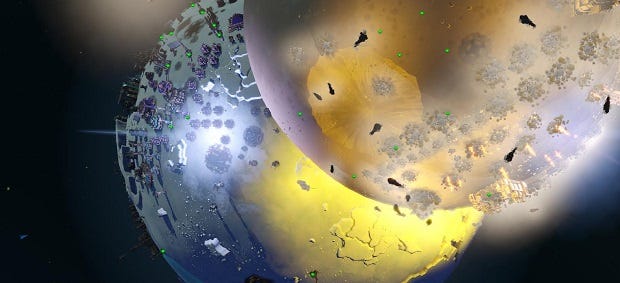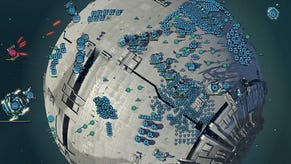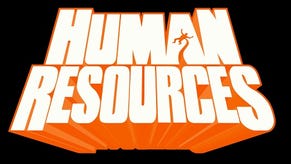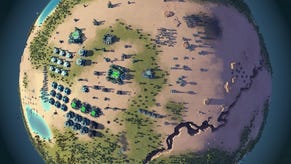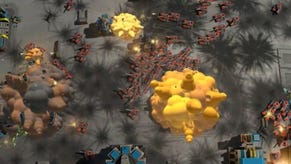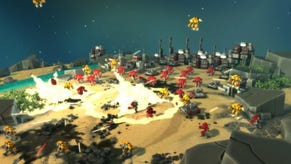Wot I Think: Planetary Annihilation
Rise of the robots
Planetary Annihilation is best enjoyed if you are a robot. A cold, cybernetically enhanced supercomputer capable of thousands of thoughts per nanosecond. No emotion, no mercy. Just a deathly, speedy logic and a finger that clicks like a woodpecker’s beak. It is a brilliant, ludicrous RTS and I will probably never try to play it again. Because I am a frail, fleshy human being whose idea of multi-tasking is using a fork AND a knife at the dinner table. But you may not be like me. You may be one of the Machines.
The year is 2014. StarCraft 2 bestrides the world like an esports colossus, with one foot in Townsville, America and the other in the Cybertopian Republic of South Korea. Along comes Planetary Annihilation, fresh out of Kickstarter, looking to get a piece of the action. It is purpose-built for Twitch (the game has keyboard shortcuts to begin broadcasting) and the main menu is a hub of popular YouTube videos related to the game. Stuff like “Tips to become a better PA player” and so on. The ‘Chrono Cam’ allows you to play back your match from any perspective and there are servers full of recordings of multiplayer skirmishes. You get a sense, as you fire up another doomed match, that the developers aren’t just making a game, they’re creating a spectator sport.
The game itself has some wonderful gimmickry. Each match is played in a solar system, often containing more than one planet. These are planets in the Super Mario Galaxy sense, where it only takes a few minutes to circumnavigate the world. The camera zooms out smoothly to take in the whole picture and transferring focus between planets is a cinch. It has to be, for the speed you will be playing at. Anyway, you have landed. Now, use your Commander to build up your forces and economy in the traditional RTS fashion. At all costs, you must keep your Commander alive. When he dies (in a spectacular nuclear blast caused by his damaged core) you will lose.
The single-player Galactic Campaign sees you bouncing from one system to another, collecting tech upgrades (advanced units, increased damage, etc) and fighting through strongholds of enemies. But this game mode is almost an afterthought. In essence, it is only a randomised set of fights on a ‘world map’ that can be uncovered as you go. There is no overarching strategy. It’s just a list of battles with a lucky dip thrown in. After a go at the Galactic Campaign I just went straight to Skirmish Mode if I wanted to fight against the computer. This, at least, gave me some choice over which planet I was murdered on.
The joy of having a whole solar system to skirmish in is clear. It adds another level of warfare to the fight. As well as building an army of troops, tanks, planes and boats, you also have to consider the orbital theatre. Satellites can scout huge areas of land, orbital fighters can protect your geostationary factory and an orbital laser platform can pour hot lasery death on anything below. The orbital launcher (a cute rocket platform that fires your first satellites into space) is also required to move units from one planet to another. Each orbital transport can only carry one unit, so getting an actual foothold on an enemy-occupied orb is a hugely tricky operation. I was only once successful. I planted a fabricator (builder dude) down on my opponent’s homeworld and instantly built a teleporter. Dozens of my boys swarmed through the machine -- a full on interplanetary invasion. Then I found the enemy commander.
He had glitched. He was sitting on his robo-laurels, doing sweet F. A.
This was an unusual case, the game is not so buggy. There were a couple of instances of units getting trapped but not enough to break the flow of battle. Most of the time the AI enemy was murderous, lethally quick, and nigh unbeatable (even on Normal setting). The enemy commander will send constant raids of tanks and war-bots against your base as well as attacking any vulnerable metal extractors you have set up. Often these war parties will circle your HQ like salivating hyenas, nipping in to destroy a power plant or a radar dish, before falling back to continue their campaign of harassment around the globe.
The wider manoeuvres of the AI are, likewise, intelligent and adaptive. In one battle, my base was located beside an expanse of water that I foolishly neglected. Realising that my AI foe had built his entire campaign on the back of a naval fleet, I built a battery of huge artillery cannons that would sink anything within range. The computer’s first wave of strike ships was folly, as my artillery bombarded them to bits and my bombers finished off the stragglers. But within ten or fifteen minutes, he had returned. This time with enough anti-air ships to devastate my patrolling bombers along with his own (scarily powerful) artillery vessels. By the time I struggled to frighten off this wave, I had lost half a dozen buildings. That was okay. At least I still had my -- oh no. My metal fields. I had been so absorbed in the naval battle that I hadn’t even noticed the land-based attack on my precious resources, on the other side of my base. Now, my HQ was decimated, my air units were obsolete and my economy was screwed.
And all the while those hit-and-run raids keep pecking at your sides, then melting back into the fog of war when you send a response team to get them. It’s that guerilla regard for warfare that makes me think the AI is actually intelligent, and not just a computer racing to produce the most units (although, at the rate they do this, I can see why people would get that impression). During raids, the computer won’t even engage you if he thinks he won’t win. You’re not just fighting AI here, you’re fighting robo-Sun Tzu.
So the computer is bewilderingly smart, quick-witted and aggressive, sometimes to the point of frustration. Like I say, I am a fleshy human. I need someone with flaws like my own to play against, so I went online to find some other meatbags to cavort with. But it turns out that the playerbase of Planetary Annihilation are AIs as well. They masquerade as human, yes, but it is clear that they see nothing but the clear red polygons of a war machine. Look at this graph of a match. It shows the amount of commands given by me (in red) and the amount given by my, allegedly human, opponent (purple). There can be no doubt. He is a robot.
Like I’ve said, invasions are tricky. There’s a lot of micro-management when it comes to moving your troops. Often I would set certain troops to patrol automatically (my fighters and bombers would circle my homelands like flies round a carcass) but when it comes to going on the offensive, having a strong combo of troops in high enough numbers is a difficult task. It is hard to predict exactly what you may need and get those war-rats out in sufficient quantity, even with scouts keeping an eye on the make-up of your enemy’s army. There’s nothing available like the huge assault bots and flying saucers of the Supreme Commander series, so total devastation often relies on swamping the other team with masses of units from as many directions as possible. It’s very satisfying but also, like anything in this game, insanely hard to pull off because of the pressure put on you by the enemy. If you want to pump out enough troops to match the murderbots of Planetary Annihilation, your economy is the key to success.
Your resources are metal (gathered from deposits by stationary extractors) and energy (produced by power plants). It’s a rolling economy, which means you’ll be building as you collect, producing things faster or slower depending on your income and output. This means you have to play a terse economic balancing act amid all the military posturing, always glancing up at your efficiency rating when the going gets tough. Somewhat counter-intuitively, ‘100%’ efficiency is a bad thing because it means you are wasting metal and energy that could be used RIGHT NOW. But obviously, an efficiency rating too low means you’re not collecting enough to replace your dwindling stash of metal bits and, I don’t know, energons?
This would be bad. You’re going to need those energons later on because Planetary Annihilation’s endgame is ridiculous, excellent stuff. Whole wars can be won or lost in an interplanetary nuclear exchange. The nuke silos and anti-nuke defence systems are the first thing I would build if my enemy and I became entrenched on our own planets. But they take a long time to arm and are very costly. More than once I was the victim of a preemptive strike. One well-placed nuke destroyed three of my silos. It was heart-breaking. Chalk up another victory for the automatons.
The most gobsmacking route to victory, however, is the one shown off in a lot of the game’s advertisements. It involves sending a team of builder dudes to a far-flung planetoid, building a huge thruster, igniting said thruster, and steering the planetoid itself into your enemy’s homeworld. The destruction is immense, unavoidable and hilarious. I was the victim of this planet-smashing technique, though not in the way intended.
During one team match I was forced to retreat my commander offworld. I (perhaps unwisely) chose to set up shop on a distant, rocky world. When some fabricators controlled by my ally turned up, I was ecstatic. Back-up! Good stuff. It was only when my comrade fired up the engines on what I thought was just a big factory, that I began to regret my strategy. In the end, we won. But only because my ally had used my planetoid in a giant game of marbles. My entire army perished on impact. But the enemy was destroyed. A noble sacrifice? No. A calculated tactic. To this cold, robotic mind I was literally less useful to my team than the land I stood on.
Machines.
Planetary Annihilation is a slick, modernised RTS, engineered from the ground up to appeal to the fast-paced, competitive, hotkey-loving esports crowd. For people like me, it is a bruising gauntlet of defeat. But even I can see the appeal. Putting aside the fact that to play online you need a quad-core processor instead of a brain, the game itself has a huge amont of character. Even if it doesn’t supplant StarCraft as the RTS du jour, I’m confident it’ll attract a sizeable following. The ‘story’ of Planetary Annihilation’s universe is that humans have gone extinct and self-replicating robots have woken up to carry on their endless war against one another. Judging from the multiplayer servers, that seems about right.
